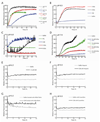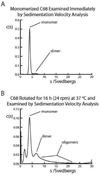The 8 and 5 kDa fragments of plasma gelsolin form amyloid fibrils by a nucleated polymerization mechanism, while the 68 kDa fragment is not amyloidogenic
- PMID: 19904968
- PMCID: PMC2907741
- DOI: 10.1021/bi901368e
The 8 and 5 kDa fragments of plasma gelsolin form amyloid fibrils by a nucleated polymerization mechanism, while the 68 kDa fragment is not amyloidogenic
Abstract
Familial amyloidosis of Finnish type (FAF), or gelsolin amyloidosis, is a systemic amyloid disease caused by a mutation (D187N/Y) in domain 2 of human plasma gelsolin, resulting in domain 2 misfolding within the secretory pathway. When D187N/Y gelsolin passes through the Golgi, furin endoproteolysis within domain 2 occurs as a consequence of the abnormal conformations that enable furin to bind and cleave, resulting in the secretion of a 68 kDa C-terminal fragment (amino acids 173-755, C68). The C68 fragment is cleaved upon secretion from the cell by membrane type 1 matrix metalloprotease (MT1-MMP), affording the 8 and 5 kDa fragments (amino acids 173-242 and 173-225, respectively) comprising the amyloid fibrils in FAF patients. Herein, we show that the 8 and 5 kDa gelsolin fragments form amyloid fibrils by a nucleated polymerization mechanism. In addition to demonstrating the expected concentration dependence of a nucleated polymerization reaction, the addition of preformed amyloid fibrils, or "seeds", was shown to bypass the requirement for the formation of a high-energy nucleus, accelerating 8 and 5 kDa D187N gelsolin amyloidogenesis. The C68 fragment can form small oligomers, but not amyloid fibrils, even when seeded with preformed 8 kDa fragment plasma gelsolin fibrils. Because the 68 kDa fragment of gelsolin does not form amyloid fibrils in vitro or in a recently published transgenic mouse model of FAF, we propose that administration of an MT1-MMP inhibitor could be an effective strategy for the treatment of FAF.
Figures





Similar articles
-
Gelsolin amyloidosis: genetics, biochemistry, pathology and possible strategies for therapeutic intervention.Crit Rev Biochem Mol Biol. 2012 May-Jun;47(3):282-96. doi: 10.3109/10409238.2012.661401. Epub 2012 Feb 24. Crit Rev Biochem Mol Biol. 2012. PMID: 22360545 Free PMC article. Review.
-
Chaperone nanobodies protect gelsolin against MT1-MMP degradation and alleviate amyloid burden in the gelsolin amyloidosis mouse model.Mol Ther. 2014 Oct;22(10):1768-78. doi: 10.1038/mt.2014.132. Epub 2014 Jul 15. Mol Ther. 2014. PMID: 25023329 Free PMC article.
-
Heparin binds 8 kDa gelsolin cross-β-sheet oligomers and accelerates amyloidogenesis by hastening fibril extension.Biochemistry. 2011 Apr 5;50(13):2486-98. doi: 10.1021/bi101905n. Epub 2011 Mar 15. Biochemistry. 2011. PMID: 21348501 Free PMC article.
-
The amyloidogenicity of gelsolin is controlled by proteolysis and pH.Chem Biol. 1999 May;6(5):293-304. doi: 10.1016/S1074-5521(99)80075-1. Chem Biol. 1999. PMID: 10322122
-
Gelsolin-related familial amyloidosis, Finnish type (FAF), and its variants found worldwide.Amyloid. 1998 Mar;5(1):55-66. doi: 10.3109/13506129809007291. Amyloid. 1998. PMID: 9547007 Review.
Cited by
-
Identification of fibrillogenic regions in human triosephosphate isomerase.PeerJ. 2016 Feb 4;4:e1676. doi: 10.7717/peerj.1676. eCollection 2016. PeerJ. 2016. PMID: 26870617 Free PMC article.
-
Rational Design of a Peptidomimetic Inhibitor of Gelsolin Amyloid Aggregation.Int J Mol Sci. 2022 Nov 12;23(22):13973. doi: 10.3390/ijms232213973. Int J Mol Sci. 2022. PMID: 36430461 Free PMC article.
-
Molecular basis of a novel renal amyloidosis due to N184K gelsolin variant.Sci Rep. 2016 Sep 16;6:33463. doi: 10.1038/srep33463. Sci Rep. 2016. PMID: 27633054 Free PMC article.
-
Development of an in vitro aggregation assay for long synthetic polypeptide, amyloidogenic gelsolin fragment AGelD187N 173-242.PLoS One. 2023 Aug 17;18(8):e0290179. doi: 10.1371/journal.pone.0290179. eCollection 2023. PLoS One. 2023. PMID: 37590229 Free PMC article.
-
Gelsolin amyloidosis: genetics, biochemistry, pathology and possible strategies for therapeutic intervention.Crit Rev Biochem Mol Biol. 2012 May-Jun;47(3):282-96. doi: 10.3109/10409238.2012.661401. Epub 2012 Feb 24. Crit Rev Biochem Mol Biol. 2012. PMID: 22360545 Free PMC article. Review.
References
-
- Kelly JW. Alternative conformations of amyloidogenic proteins govern their behavior. Curr. Opin. Struct. Biol. 1996;6:11–17. - PubMed
-
- Kelly JW. The alternative conformations of amyloidogenic proteins and their multi-step assembly pathways. Curr. Opin. Struct. Biol. 1998;8:101–106. - PubMed
-
- Selkoe DJ. Folding proteins in fatal ways. Nature. 2003;426:900–904. - PubMed
-
- Dobson CM. Protein folding and misfolding. Nature. 2003;426:884–890. - PubMed
-
- Cohen FE, Kelly JW. Therapeutic approaches to protein-misfolding diseases. Nature. 2003;426:905–909. - PubMed
Publication types
MeSH terms
Substances
Grants and funding
LinkOut - more resources
Full Text Sources
Medical
Molecular Biology Databases
Research Materials

